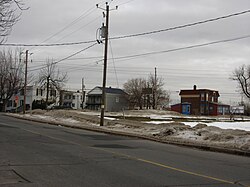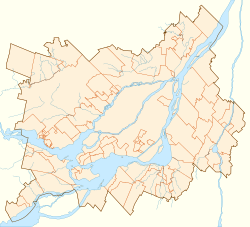Le Moyne (French pronunciation: [lə mwan]; also known as Ville Le Moyne, formerly known as LeMoyne) is a neighbourhood in Longueuil, Quebec, part of the borough of Le Vieux-Longueuil, and a former city. Le Moyne makes up 2% of the total area of Le Vieux-Longueuil borough and is the only neighbourhood of the borough that was not part of the pre-2002 city of Longueuil. Residents of Le Moyne are called Le Moynois.
Le Moyne, Quebec | |
|---|---|
Neighbourhood | |
 Houses on Saint-Georges Street | |
| Motto(s): | |
Location of Le Moyne in Greater Montreal | |
| Coordinates: 45°30′07″N 73°29′26″W / 45.501889°N 73.490611°W | |
| Country | |
| Province | |
| City | Longueuil |
| Borough | Le Vieux-Longueuil |
| Established | 1949 |
| Merger with Longueuil | January 1, 2002 |
| Government | |
| • Le Moyne-Jacques-Cartier City Councillor | Colette Éthier (AL) |
| Area | |
| • Land | 1.00 km2 (0.39 sq mi) |
| Population | |
• Total | 4,813 |
| • Density | 4,813.0/km2 (12,466/sq mi) |
| • Change * | |
| • Dwellings | 2,815 |
| Time zone | UTC-5 (EST) |
| • Summer (DST) | UTC-4 (EDT) |
| Area code | 450 |
| Access Routes [3] | |
The municipal electoral district of Le Moyne-Jacques-Cartier corresponds to the territory of Le Moyne, along with a portion from the former city of Longueuil.
History
editAccording to local historian Michel Pratt, the name "Le Moyne" was chosen by Redmond Roche of the Union Nationale, in honour to Charles Le Moyne.
The town hall of Le Moyne was originally on Saint-Louis Street near Laurier Street.[4] In 1967, the town hall was moved to 2205 Saint-Georges Street where it remained until the 2002 merger of Le Moyne with Longueuil.[5][6] It is now a fire station for the city of Longueuil.
The last of motto of Le Moyne, before its annexation into Longueuil, was Droit et Loyal (English translation: Right and Loyal)
On January 1, 2002, Le Moyne ceased to exist as a municipality and was amalgamated into the city of Longueuil to become part of the Saint-Lambert/Le Moyne borough. However, on June 20, 2004 Saint-Lambert voted to demerge from Longueuil and on January 1, 2006 regained its status of city, while Le Moyne opted to stay in Longueuil.
After the demergers, Le Moyne joined Le Vieux-Longueuil borough following the results of a 2005 referendum in which the residents of Le Moyne were given the choice to pick a new borough between Le Vieux-Longueuil, Saint-Hubert and Greenfield Park.
Demographics
edit| Year | Pop. | ±% |
|---|---|---|
| 1951 | 4,078 | — |
| 1961 | 8,057 | +97.6% |
| 1971 | 8,184 | +1.6% |
| 1981 | 6,137 | −25.0% |
| 1991 | 5,412 | −11.8% |
| 1996 | 5,052 | −6.7% |
| 2001 | 4,855 | −3.9% |
| 2006 | 5,149 | +6.1% |
| 2011 | 4,813 | −6.5% |
| [7][8] | ||
| Language | Population | Percentage (%) |
|---|---|---|
| French | 4,185 | 81.6% |
| English | 440 | 8.6% |
| Both English and French | 30 | 0.6% |
| Other languages | 475 | 9.3% |
Mayors
edit| Mayor | Term Began | Term Ended |
|---|---|---|
| Henri Sicotte | 1949 | 1952 |
| Albert Bélanger | 1952 | 1954 |
| Jean Baribeau | 1954 | 1967 |
| André Charpentier | 1967 | 1977 |
| Michel Sicotte | 1977 | 1981 |
| Louise Gravel | 1981 | 1993 |
| Guy Talbot | 1993 | 2001 |
| Part of Longueuil | 2002 | present |
Saint-Maxime and Saint-Josaphat
editLe Moyne is divided into two sections separated by Route 112. They are Saint-Maxime and Saint-Josaphat, the two Catholic parishes that are the ancestors of Le Moyne.
Route 112 is called Saint-Louis Street in Saint-Maxime. Saint-Maxime has the shape of rectangle and is located from Saint-Louis Street to the limits of Greenfield Park. Saint-Maxime Church, built in 1918, is on Charron Street.
In Saint-Josaphat, Route 112 is called Sir Wilfrid-Laurier Boulevard. Saint-Josaphat has the shape somewhat of a boomerang or a hockey stick, and is located from Sir Wilfrid Laurier Boulevard to the limits of the former city of Longueuil. Saint-Josaphat Church is located on De L'Église Street.
Notable people
edit- Maxime Talbot, former NHL player
See also
editReferences
edit- ^ a b Moyne&SearchType=Begins&SearchPR=24&B1=Custom&Custom=1000,8000,9000 2006 Statistics Canada Community Profile
- ^ a b "Census Profile: Census Tract: 4620866.00". Canada 2011 Census. Statistics Canada. 8 February 2012. Retrieved 10 July 2012.
"Census Profile: Census Tract: 4620865.00". Canada 2011 Census. Statistics Canada. 8 February 2012. Retrieved 10 July 2012. - ^ Official Transport Quebec Road Map
- ^ Lovell's Montreal suburban Cross reference directory (PDF). Vol. 5. Lovell. 1966–1967. p. 166.
- ^ Lovell's Montreal suburban Cross reference directory (PDF). Vol. 6. Lovell. 1967–1968. p. 176.
- ^ Lovell's Montreal suburban Cross reference directory (PDF). Vol. 2. Lovell. 2001–2002. p. 246.
- ^ Pratt, Michel. "De la balkanisation des villes à leur fusion". Société historique et culturelle du Marigot. Retrieved 24 October 2013.
- ^ Statistics Canada: 1996, 2001, 2006, 2011 census
